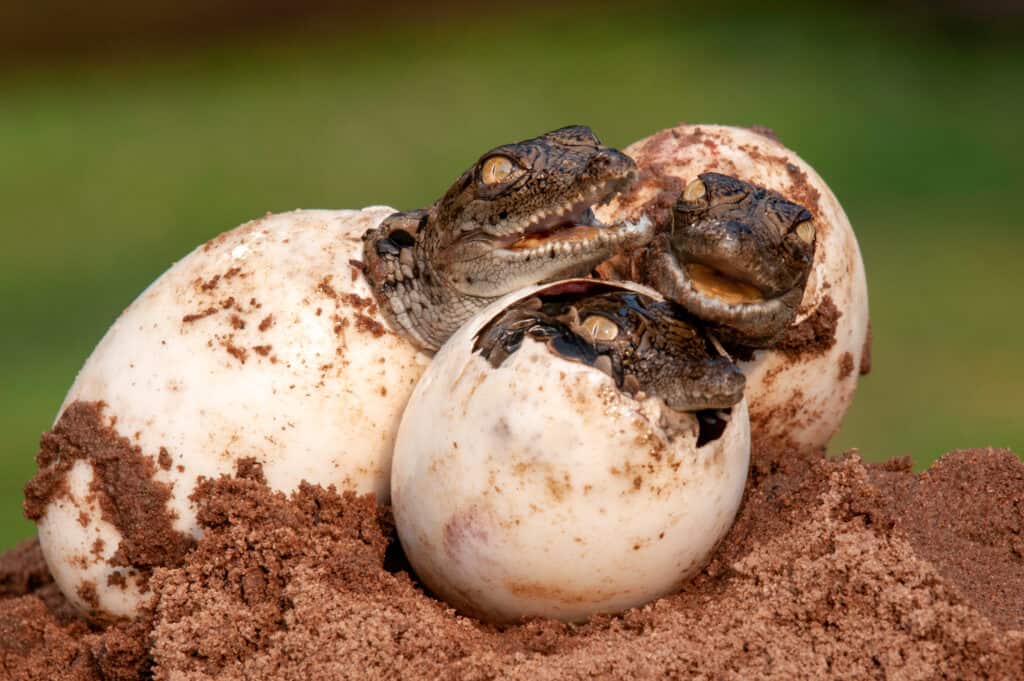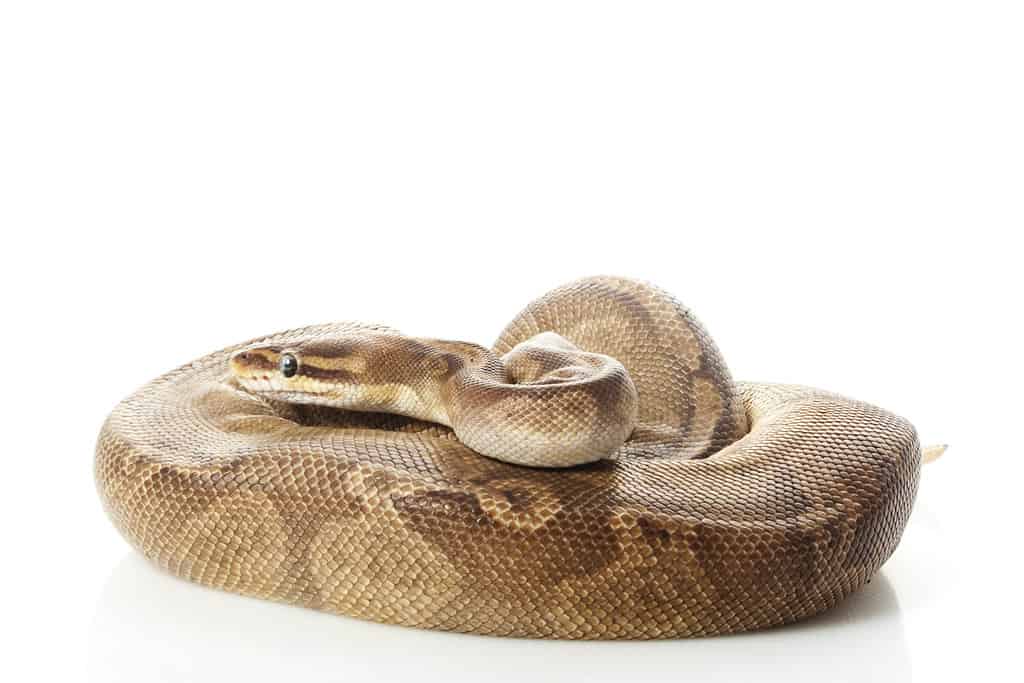Zookeepers thought the crocodile was a male, that is, until “he” began guarding a nest of 14 eggs. An 18-year-old crocodile named Coquita, living in a zoo in Costa Rica, is the latest creature to exhibit a virgin birth in captivity. Having lived alone for sixteen years, she gave scientists a surprise when she laid 14 eggs, seven of which were fertile. While none of these eggs successfully hatched, they provided indisputable proof that Coquita had reproduced through parthenogenesis. Parthenogenesis, a reproductive process that does not require male fertilization, has been documented across a wide range of animal species. Read on to learn all about this amazing crocodile’s story, and other animals like her.
Did a Crocodile Really Have a Virgin Birth?

After 16 years of living alone, an 18-year-old crocodile suddenly laid 14 eggs.
©Audrey Snider-Bell/Shutterstock.com
Did a crocodile in Costa Rica really experience a virgin birth? Yes, and this discovery totally blew away scientists! After living alone for 16 years, the 18-year-old female named Coquita suddenly laid 14 eggs. There’s almost no way she could have mated with a male crocodile, so it’s strong evidence that crocodiles can reproduce through parthenogenesis, where they can have babies without needing a male’s contribution in fertilizing the eggs. Zoo keepers quickly took care of the seven eggs, which seemed to be fertile, through artificial incubation. One of the eggs contained a fully formed crocodile fetus, proving that Coquita reproduced without mating with a male crocodile.
What’s even crazier is that zoo keepers initially thought Coquita the crocodile was a male. But they learned otherwise when she began acting aggressively and guarding a nest. This discovery really makes you wonder. How often do these offspring happen, and can they actually survive?
Did the Eggs Hatch?
Out of the 14 eggs found in the nest, seven appeared to be fertile and were incubated, but none hatched. Genetic analysis revealed that one of the eggs contained a partially cloned fetus, providing evidence of a virgin birth. The baby crocodile’s body was able to prove that Coquita had produced the young on her own through parthenogenesis. DNA analysis confirmed that the offspring had a 99.9% match to its mother’s genetic makeup, which adds up.
In the case of the baby crocodile we’re talking about, it’s likely that it was female. The reason for this has to do with the temperature it experienced while developing inside the egg. When a female crocodile goes through the reproductive process, she typically lays a bunch of eggs, usually between 30 to 60 of them. These eggs then spend about 80 to 90 days in an incubation period. The temperature within the nest during this incubation period impacts the sex of the hatchlings that will eventually emerge.
How Did the Crocodile Have a Virgin Birth?

Female crocodile egg cells can behave like sperm, allowing them to reproduce asexually.
©Catchlight Lens/Shutterstock.com
Female American crocodiles have the ability to reproduce via parthenogenesis, a process in which offspring are possible without the involvement of males. Parthenogenesis happens in various vertebrate species in captivity and the wild.
Here’s how a crocodile’s virgin birth works:
- Female crocodile egg cells behave like sperm
- Special cells fuse with the egg
- Embryo development begins
Female crocodile egg cells exhibit sperm-like behavior; special cells fuse with the egg, leading to embryo development. The python process involves merging the egg’s nucleus with a structure called the second polar body, resulting in baby snakes that are exact copies of their mother. Overall, parthenogenesis involves several cellular events. There’s the creation of egg cells without sperm, independent development of eggs, and, hopefully, successful hatching.
The process can fail at various steps, resulting in offspring with varying levels of genetic similarity to the mother. DNA analysis tools are now widely available, simplifying the process of identifying parthenogenesis and comprehending its ecological and evolutionary importance. This research has unlocked new opportunities to study this reproductive mechanism, which was previously seen as a rare occurrence.
Despite new research tools, there are still a lot of questions surrounding this new crocodile discovery. Like, what exactly triggers parthenogenesis in crocodiles? And why did it take 18 years for that female crocodile to reproduce using this method? It could’ve been spontaneous, or maybe there was a change in the environment. Environmental changes, stressors, and high salinity can trigger parthenogenesis.
Are Crocodile Oviparous or Viviparous?
Crocodilians, which include crocodiles, alligators, and caimans, are oviparous. The eggs are produce and hatch outside the body of the female. The female crocodilian constructs a nest, which is usually mounds of vegetation, to lay her eggs. In contrast, viviparity is the reproductive strategy in which an animal develops embryos inside the female’s body, resulting in a live birth.
Other Animals That Have Virgin Births

Pythons are another type of animal that can have a virgin birth.
©fivespots/Shutterstock.com
What animals have virgin births? There are quite a few. Virgin births aren’t as rare as you might think. They’re a natural part of how some animals evolve and reproduce. The process lets animals pass on their genes without the need to find a mate, which can be beneficial in challenging conditions. For instance, female American cockroaches can have babies without a male. Virgin female cockroaches housed together have quicker births compared to those living alone.
Here are a few more animals that can have virgin births:
- Python
- Zebra Shark
- Yellow-bellied Water Snake
- Komodo Dragon
- Boa Constrictor
- Sawfish
- California condor
- Pit Viper
- Bees
- Ants
- Wasps
- Atlantic Blacktip Shark
- Hammerhead Shark
- Cockroach
Certain bird species, including turkeys, finches, quails, and California condors, have females that can lay clutches of all male eggs through parthenogenesis. And it’s not just birds! Female sharks also have the ability to give birth to litters of exclusively female baby sharks without mating. Parthenogenesis is common for small invertebrates like bees, wasps, ants, and aphids. Researchers speculate that turtles may be the next group of animals to show evidence of facultative parthenogenesis.
Are there any mammals that can have virgin births? Currently, there aren’t any mammals we know about that use parthenogenesis. This is because mammals need to undergo genomic imprinting. This process requires genes from both parents for viable offspring. And virgin births only provide genes from one parent.
Did Dinosaurs Reproduce Asexually?

It’s possible dinosaurs had the ability to reproduce asexually, just like the crocodile.
©iStock.com/MR1805
Did dinosaurs have virgin births? It’s possible. Certain dinosaurs may have had the ability to switch between sexual reproduction and parthenogenesis. Previously it was thought dinosaurs could only reproduce through mating. Males would deposit sperm inside females, who would then lay fertilized eggs containing developing dinosaur embryos. But the recent discovery of the virgin crocodile birth makes scientists think twice. The parthenogenesis observed in crocodiles shares similarities with the reproductive processes of birds and other reptiles. This suggests a potential common ancestor between these creatures, including dinosaurs. While it cannot be definitively stated that dinosaurs could reproduce asexually, it’s a definite possibility.
Dinosaurs and Live Births
Did all dinosaurs lay eggs? It was previously thought to be the case, but the discovery of a really old fossil, about 250 million years old, challenges that assumption. This fossil belongs to a creature called Dinocephalosaurus, which is part of a larger group called Archosauromorpha. This fossil had an embryo inside the mother, suggesting that Dinocephalosaurus gave live birth. This is quite unexpected because it was previously thought these animals only reproduced by laying eggs. Dinocephalosaurus is currently the only known member of the Archosauromorpha group to have given live birth, although there is a possibility that the metriorhynchids, a group of marine crocodylomorphs, might have also done so.
The photo featured at the top of this post is © WeStudio/Shutterstock.com
Thank you for reading! Have some feedback for us? Contact the AZ Animals editorial team.






